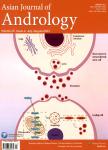Significance of preoperatively observed detrusor overactivity as a predictor of continence status early after robot-assisted radical prostatectomy
Significance of preoperatively observed detrusor overactivity as a predictor of continence status early after robot-assisted radical prostatectomy作者机构:Division of Urology Kobe University Graduate School of Medicine 7-5-1 Kusunoki-Cho Chuo-Ku Kobe Japan.
出 版 物:《Asian Journal of Andrology》 (亚洲男性学杂志(英文版))
年 卷 期:2014年第16卷第6期
页 面:869-872页
核心收录:
学科分类:090603[农学-临床兽医学] 1002[医学-临床医学] 08[工学] 09[农学] 0906[农学-兽医学] 0802[工学-机械工程] 080201[工学-机械制造及其自动化]
主 题:detrusor overactivity robot-assisted radical prostatectomy urinary incontinence
摘 要:Several recent studies have reported the involvement of bladder dysfunction in the delayed recovery of urinary continence following radical prostatectomy (RP). The objective of this study was to investigate the significance of detrusor overactivity (DO) as a predictor of the early continence status following robot-assisted RP (RARP). This study included 84 consecutive patients with prostate cancer undergoing RARP. Urodynamic studies, including filling cystometry, pressure flow study, electromyogram of the external urethral sphincter and urethral pressure profile, were performed in these patients before surgery. Urinary continence was defined as the use of either no or one pad per day as a precaution only. DO was preoperatively observed in 30 patients (35.7%), and 55 (65.5%) and 34 (40.5%) were judged to be incontinent 1 and 3 months after RARP, respectively. At both 1 and 3 months after RARP, the incidences of incontinence in patients with DO were significantly higher than in those without DO. Of several demographic and urodynamic parameters, univariate analyses identified DO and maximal urethral closure pressure (MUCP) as significant predictors of the continence status at both 1 and 3 months after RARP. Furthermore, DO and MUCP appeared to be independently associated with the continence at both I and 3 months after RARP on multivariate analysis. These findings suggest that preoperatively observed DO could be a significant predictor of urinary incontinence early after RARP; therefore, it is recommended to perform urodynamic studies for patients who are scheduled to undergo RARP in order to comprehensively evaluate their preoperative vesicourethral functions.



